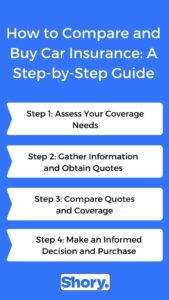

Navigating the world of car insurance can be a daunting task, especially with the multitude of options available. Ensuring that you get the best coverage at the most competitive price requires a strategic approach. This step-by-step guide will help you compare and buy car insurance with confidence.
Step 1: Assess Your Coverage Needs

Before you start comparing insurance policies, it’s essential to understand what coverage you need. Car insurance typically includes several types of coverage:
- Liability Coverage: Covers damages to other people’s property and injuries you cause to others in an accident.
- Collision Coverage: Covers damages to your car from collisions with other vehicles or objects.
- Comprehensive Coverage: Covers damages to your car from non-collision events like theft, fire, or natural disasters.
- Personal Injury Protection (PIP): Covers medical expenses and lost wages for you and your passengers.
- Uninsured/Underinsured Motorist Coverage: Protects you if you’re hit by a driver who doesn’t have adequate insurance.
Consider factors like the value of your car, your driving habits, and your financial situation to determine the appropriate level of coverage. For example, if you have a new or high-value car, comprehensive and collision coverage might be crucial. On the other hand, if you drive an older car, you might opt for minimal coverage.
Step 2: Gather Information and Obtain Quotes

Once you’ve identified your coverage needs, the next step is to gather information about potential insurers and obtain quotes. Here’s how to proceed:
- Research Insurers: Look for reputable insurance companies with strong financial stability and good customer service ratings. Online reviews and ratings from organizations like J.D. Power can provide insights into insurers’ performance.
- Use Comparison Tools: Online comparison tools can simplify the process by allowing you to input your information once and receive quotes from multiple insurers. Websites like Insure.com and NerdWallet offer these services.
- Contact Insurers Directly: For a more personalized touch, consider contacting insurers directly for quotes. This can also give you a sense of their customer service.
When obtaining quotes, be prepared to provide detailed information about your car (make, model, year, VIN) and your driving history (accidents, violations, annual mileage). This ensures that the quotes you receive are accurate and tailored to your specific situation.
Step 3: Compare Quotes and Coverage

After gathering several quotes, it’s time to compare them. Don’t just look at the premium amounts—consider the overall value of each policy. Here’s what to look for:
- Coverage Limits and Deductibles: Ensure that the coverage limits and deductibles align with your needs. Higher limits offer more protection but can increase premiums, while higher deductibles can lower premiums but increase out-of-pocket costs in the event of a claim.
- Additional Benefits: Some policies come with extras like roadside assistance, rental car reimbursement, or accident forgiveness. Evaluate whether these benefits are worth the additional cost.
- Discounts: Many insurers offer discounts for things like bundling policies, having a good driving record, or installing safety features in your car. Make sure you’re taking advantage of all available discounts.
- Customer Service and Claims Process: Consider the insurer’s reputation for customer service and the ease of their claims process. You want an insurer that will be responsive and helpful if you need to file a claim.
Step 4: Make an Informed Decision and Purchase
Once you’ve thoroughly compared your options, it’s time to make an informed decision and purchase your car insurance. Here’s how to finalize your choice:
- Review the Policy Details: Carefully review the policy details, including coverage limits, deductibles, exclusions, and any additional benefits. Make sure you understand what is and isn’t covered.
- Ask Questions: If anything is unclear, don’t hesitate to ask questions. Contact the insurer or your insurance agent to clarify any doubts.
- Consider Financial Stability: Ensure that the insurer is financially stable and has a good track record of paying claims. Ratings from agencies like A.M. Best can provide insight into an insurer’s financial health.
- Finalize the Purchase: Once you’re confident in your choice, you can proceed with the purchase. Most insurers offer the option to buy policies online, over the phone, or through an insurance agent. Choose the method that’s most convenient for you.
After purchasing your policy, make sure to store your insurance documents in a safe place and keep a copy in your car. It’s also a good idea to set a reminder to review your policy annually to ensure it still meets your needs.
Final Thoughts
Comparing and buying car insurance doesn’t have to be overwhelming. By following this step-by-step guide, you can navigate the process with ease and confidence. Assess your coverage needs, gather and compare quotes, and make an informed decision to secure the best possible protection for you and your vehicle. Regularly reviewing your policy ensures that you always have the coverage you need at a price you can afford. Happy driving!











